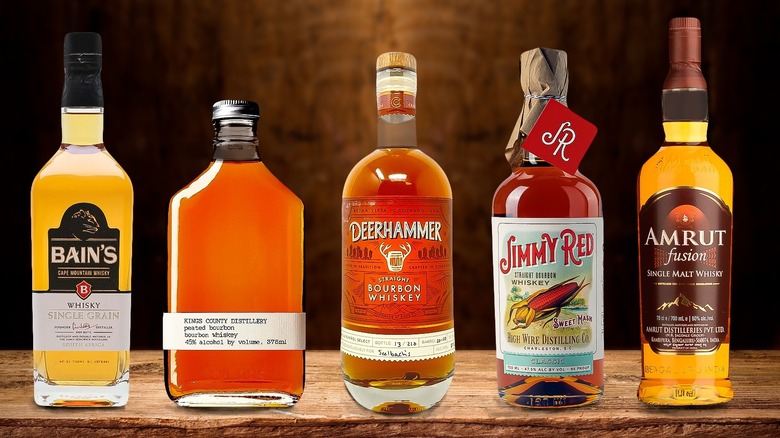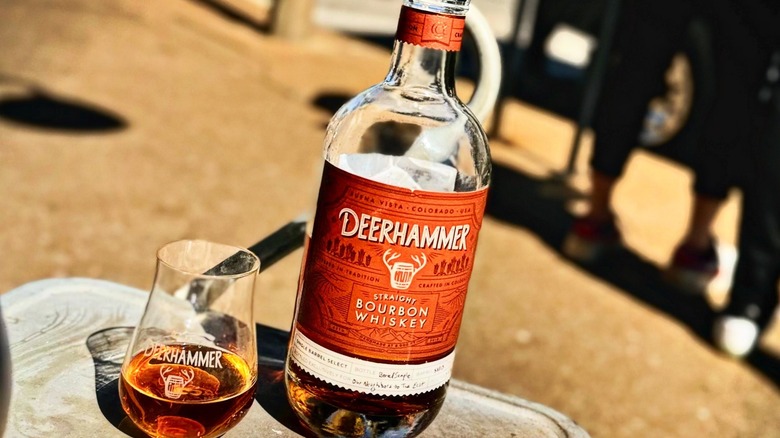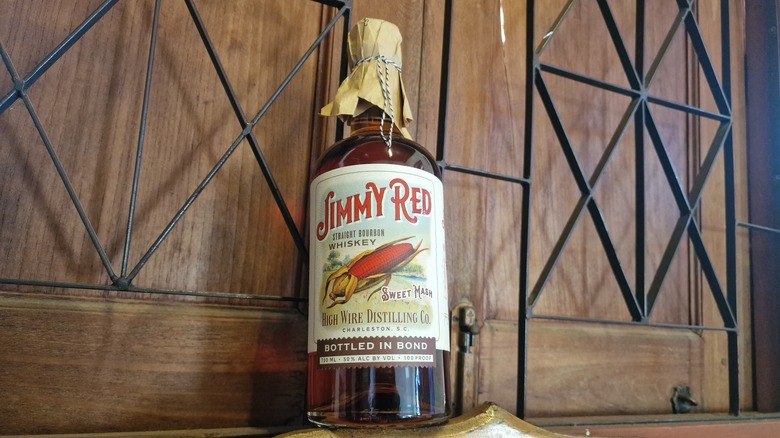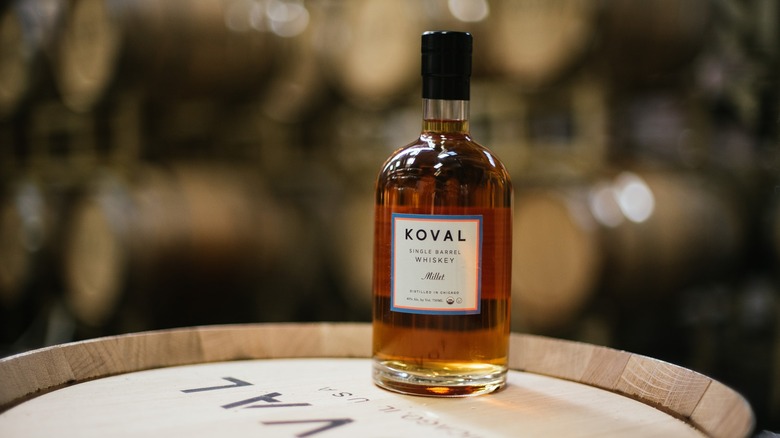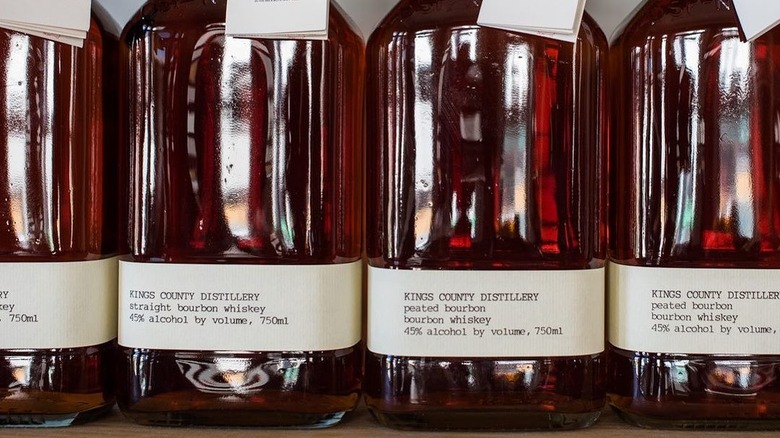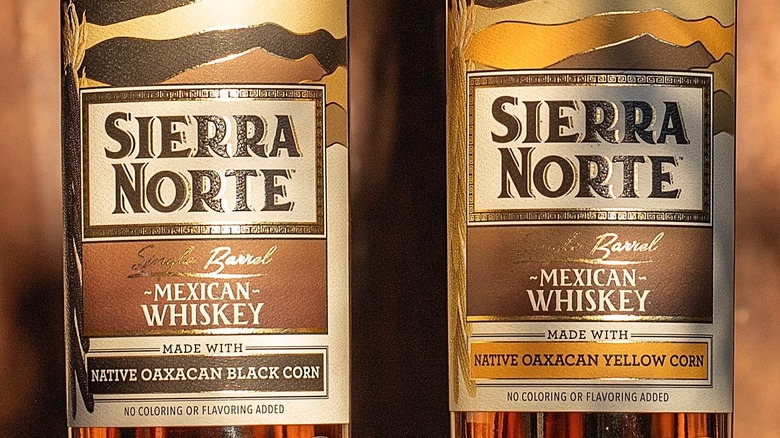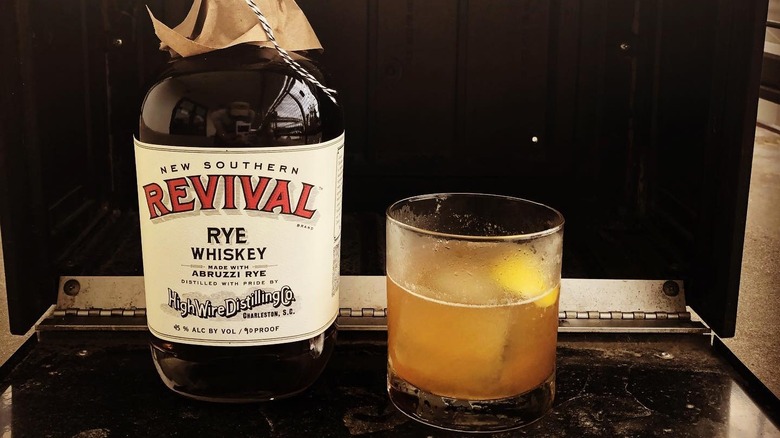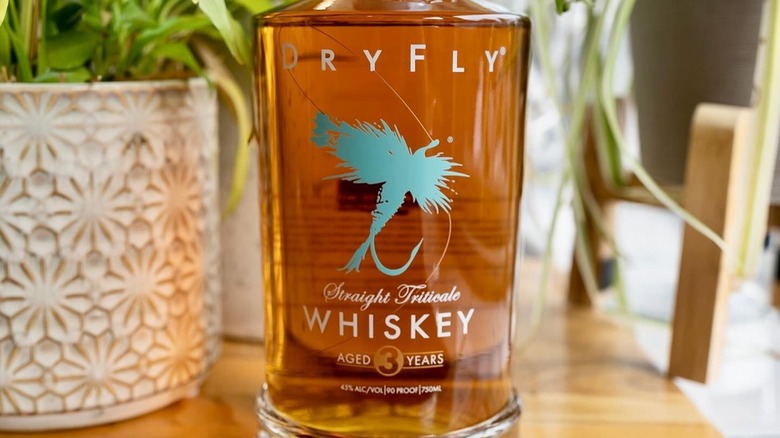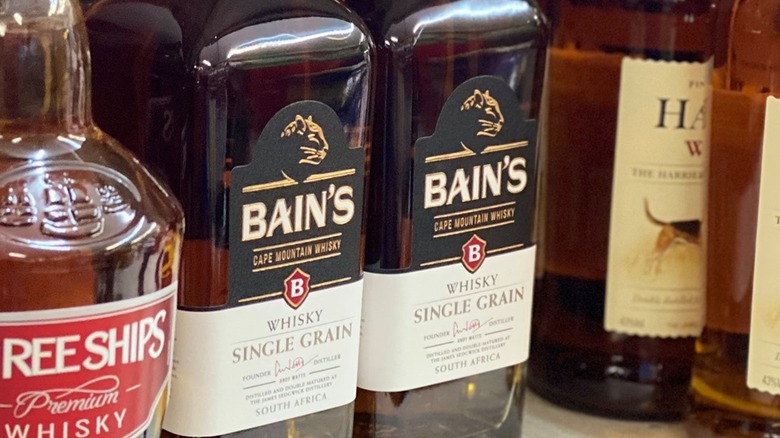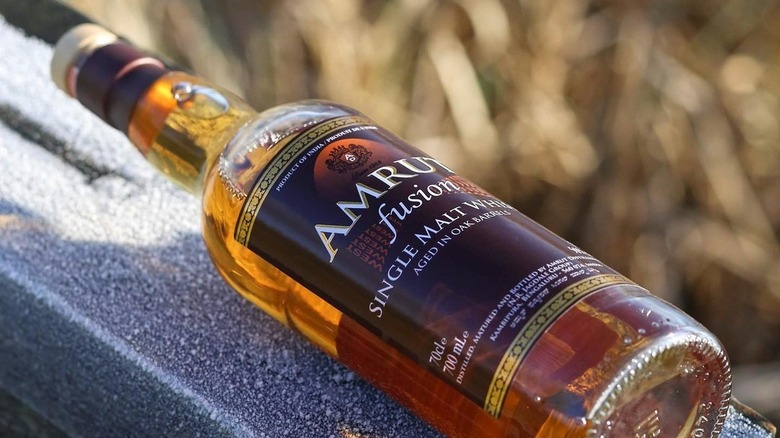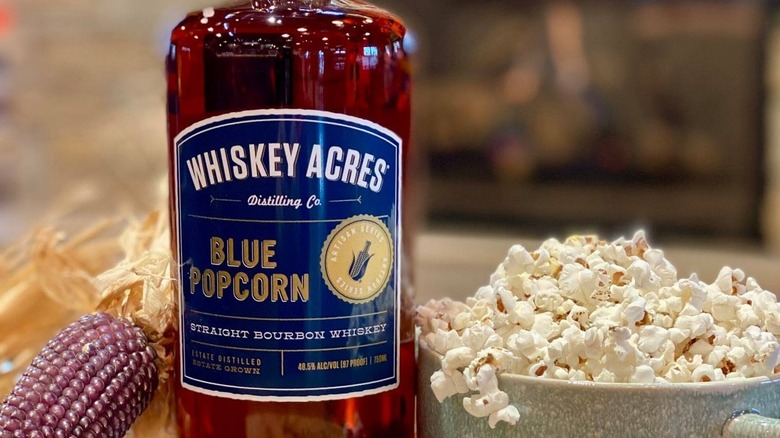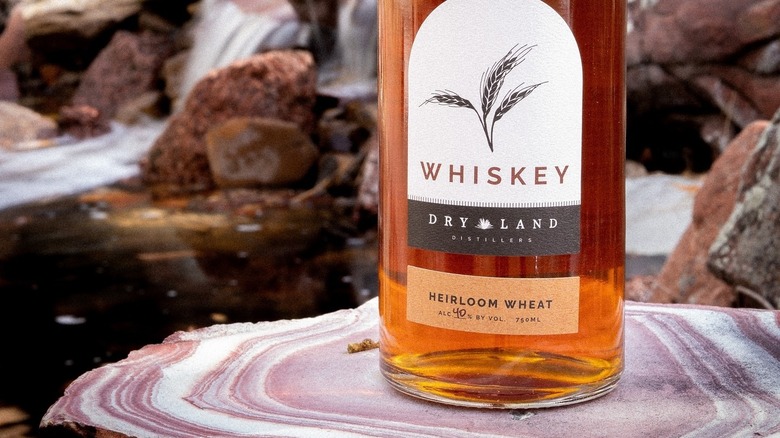11 Whiskeys With Unique Grain Profiles You Should Know About, According To An Expert
When talking about what makes a whiskey unique or particularly flavorful, people commonly focus on the aging process, overlooking the fundamental ingredients of the spirit. While aging does make a huge contribution to a whiskey's flavor, the grain profile is just as critical, and there are a handful of distilleries producing delicious drams by getting extra creative with grains.
Whiskey is made by fermenting a porridge of grains, distilling the alcoholic liquid to a higher strength, then aging it. The grain profile – also known as the mash bill – is essentially a list of the type and quantity of the grains used in the porridge. The specific type of grain can affect both the taste and the texture of the final product, so it's unsurprising that some distillers have defied the norms to create whiskeys that stand out from the competition. Some utilize heritage grains or choose grains uncommonly associated with whiskey-making, while others play around with unusual ratios. Some distillers do all of the above in their quest for exclusivity.
A long-time whiskey lover, my interest in unique grain profiles was piqued after my first visit to a whiskey distillery in the United States. A storied career in the bar industry has allowed me to indulge my curiosity for whiskeys with distinctive mash bills and gain a greater understanding of the impact they can have. The list below contains some of my favorite expressions that demonstrate just how effective experimentation with grain profiles can be.
Some recommendations are based on first-hand impressions of promotional materials and products provided by the manufacturer.
Deerhammer Straight Four-Grain Bourbon
Although bourbon is historically associated with Kentucky, it's a mistake to overlook other states that are beginning to give the style's birthplace a run for its money. Most distillers stick to three types of grain; however, Deerhammer – based in Colorado – deftly combines four in its aptly named Straight Four Grain Bourbon.
Increasing the number of grain types in a mash bill requires the skill and experience to let the attributes of each shine while also harmonizing with one another, which is why Deerhammer's dram is the perfect showcase. The bulk of the grain profile is corn – a legal requirement for a whiskey to be considered bourbon – grown in the state's Ute Mountain region. The balance consists of red wheat, oats, and roasted barley, also grown in-state. Notably, Deerhammer chose not to use rye in its mash bill, which is somewhat unusual for a bourbon.
The corn contributes familiar notes of sweet vanilla and caramel, and a full-bodied mouthfeel. While the additional grains all play a part in creating an extra smooth and creamy texture, they also bring their own flavor characteristics to the table. The wheat offers notes of honey and a bready quality which, combined with the slight nuttiness from the oats, results in hints of pecan pie and baking spices. Although barley only makes up five percent of the overall grain profile, its successful marriage with the other grains provides flavors like cocoa, cinnamon, and orange peel, making up for the lack of rye.
High Wire Jimmy Red Bottled-in-Bond Bourbon
Jimmy Red is the flagship spirit of South Carolina's High Wire Distilling Co, which has created an exemplary bourbon that pays the ultimate homage to the style. The name Jimmy Red is shared with a local corn that makes up the entire mash bill – an exceedingly rare variety with historic ties to the region's whiskey-making.
Jimmy Red corn held a long-standing reputation as a bootlegger's corn; however, it came incredibly close to extinction. In the early 2000s, the sole remaining grower of Jimmy Red corn died, and just two cobs of the variety were saved. Fortunately, these cobs were entrusted to a local farmer with a passion for reviving at-risk seeds. The farmer managed to save Jimmy Red and, once its future was secure, began offering it to a select few in the culinary world, including High Wire.
The bottled-in-bond expression of Jimmy Red is manufactured to the ultimate level of quality, and the grain provides an incredible variety of flavors that never become too corny – a risk that comes with excluding other grains. The resplendent nose of butterscotch and vanilla opens onto a palate that's drier than one expects. There are heaps of rich oak, caramel, brown sugar, candied cherries, and an almond-like nuttiness that ride upon an incredibly full mouthfeel. There are hints of pepper along with baking spice touches cinnamon and nutmeg that culminate in a supremely satisfying finish to an extremely unique yet pleasurable drinking experience.
Koval Single Barrel Millet
Multi-award-winning Koval has made a name for itself in multiple ways. Not only was it the first distillery to open in Chicago since the 1800s, but it continually strives to craft spirits using specialty organic grains and cutting-edge distilling methods.
While any one of Koval's whiskeys could make this list, arguably the most interesting is the Single Barrel Millet. Millet is an ancient grass seed with agricultural roots dating back millennia. Although millet is making a comeback, its absence in most modern diets is primarily due to the fact its yield is lower than alternatives like corn, wheat, or rice. However, millet's short growing cycle and ability to thrive in arid climates mean it's remained a staple grain in the tropics of Africa and Asia. As such, it's not particularly surprising that it flew under the radar as a whiskey grain until Koval became the first US-based distillery to give it a shot.
This expression has a remarkably clean and uncomplicated profile. This is partly due to the sole use of millet and partly due to Koval's distillation process, which retains only the purest part of the distillate. The nose shows a touch of spice with hints of anise, vanilla, and pine resin that become even more prominent on the palate. The mouthfeel is unobtrusive and while it's not necessarily thin, it's best enjoyed neat. While it's drier than bourbon, there's a pleasant sweetness to the whiskey that opens up more on the finish.
Kings County Peated Bourbon
Founded in 2010, Kings County Distillery shares a unique claim with Koval, being the first distillery to open since prohibition in its home of New York City. It's gained a solid reputation for crafting unusual whiskeys, including an unaged "moonshine" and an innovative cold brew coffee bourbon.
However, my personal favorite is Kings County's hybrid-style Peated Bourbon. The template is very much that of bourbon, with corn dominating the grain profile and aging occurring in new oak barrels. What sets this particular expression apart is how the distillery makes up the remainder of the mash bill. Rather than the typical rye or wheat, Kings County imports peated barley all the way from Scotland. Fans of scotch will be very familiar with peated whisky and its strikingly earthy, smokey profile. The flavor is attained by burning peat – a type of decomposed plant mass found in bogs – to heat the kilns in which the barley is malted, which in turn imbues the grain with the iconic smokey flavor.
Marrying these two styles successfully is no mean feat, but Kings County has managed to create an incredibly distinctive whiskey that offers the best of both worlds. The nose is unapologetically bourbon – fruity with heavy maple and just a whiff of smoke. On the palate, however, the peatiness shines, complementing the dark fruit notes and taking on a sweet barbeque aspect. The fruit fades over a long finish, leaving you with hints of bitter chocolate and bourbon-esque leather.
Sierra Norte Single Barrel
When people think of Mexican spirits, they tend to think of tequila or mezcal rather than whiskey. Given the country is the birthplace of corn itself, it's a little surprising that it's taken so long for a whiskey industry to arise.
Sierra Norte was founded in 2015 by Doug French, a master distiller with over twenty years of mezcal-making experience under his belt. The distillery itself is based in the state of Oaxaca, a choice that was no mere accident. The region's farmers are known for cultivating heirloom corn, and until recently, struggled to find an international market for their crops. This changed when Sierra Norte entered the whiskey business, with French willing to offer local farmers a fair price to take the ancestral corn off their hands.
Oaxacan corn comes in a range of styles and is differentiated by its color, a fact that's reflected in the Sierra Norte range. Each "color" brings something different to the table from a taste perspective. The yellow expression is arguably the most approachable, being relatively mild with slightly vegetal and buttery corn notes and hints of citrus and honey. If you're after something a little more interesting, the black expression is the way to go. It's richer and sweeter than its companions, with an abundance of honey and vanilla and a banana-like funk that's reminiscent of Jamaican rum.
High Wire New Southern Revival Rye
Before husband-and-wife duo Scott Blackwell and Ann Marshall, founded High Wire Distilling in 2013, they ran a highly-acclaimed organic bakery. There's no doubt this experience has contributed to its success in the whiskey world and influenced the decision to entrust the pair with Jimmy Red corn for its flagship bourbon.
This dedication to exploring the use of unique local grains in distilling is evident across High Wire's product range, which includes a gin, a vodka, and, surprisingly, an amaro. However, there has to be a special mention for the distillery's New Southern Revival Rye. This particular dram is made with 100% Wrens Abruzzi rye, a heritage strain that's been grown for centuries in the Carolinas, where High Wire is based.
The result is a rich, spicy whiskey with plenty of dark fruit notes. It has an interesting herbaceous profile, showcased by flavors of spearmint, anise, and pine. Revival also features some of the more classic attributes of a rye whiskey, with plenty of cocoa, roasted nuts, and white pepper present upon tasting. One-hundred-percent rye whiskeys can be too intense for many palates, but High Wire addresses this by using unmalted rye – an atypical approach. This allows more cereal sweetness from the unique Abruzzi grain to shine through, increasing the complexity of flavor while balancing the whiskey's more robust elements.
Dry Fly Straight Triticale
While most of us are familiar with the common grains used in whiskey-making – corn, wheat, rye, barley – triticale is slightly less well-known. It's a type of hybrid grain that was developed in Scotland in the late 19th century, and it's making something of a comeback.
Triticale is a hybrid of rye and wheat, intended to offer the hardiness of the former and the high yields of the latter. The downside is that the gluten in triticale breaks down very quickly, rendering it unsuitable for the majority of baking – instead, it's commonly used for animal feed. However, this feature isn't an issue when it comes to making whiskey.
Multiple whiskey distilleries have experimented with triticale, but Dry Fly, based out of Spokane, Washington, has arguably been the most successful at showcasing and balancing the grain's unique qualities. The nose is unabashedly rye-forward, with spicy notes of oak, vanilla, leather, and dried fruits; however, there is a slightly earthy wheat element present. The aromatic rye notes are still there on the palate, but the spiciness is tempered by the soft sweetness commonly associated with wheat whiskeys. The finish is similar, with the triticale providing characteristics from its parent styles that work in harmony to provide an incredibly accessible yet complex dram.
Bain's Cape Mountain Whisky
The James Sedgwick Distillery is arguably the most iconic whisky-producing facility on the continent of Africa, at least when it comes to matching European, American, and Japanese counterparts for innovation and quality.
Bain's Cape isn't the only brand of whisky that comes out of the James Sedgwick Distillery. However, its Single Grain whisky deserves a special mention thanks to the use of one hundred percent South Africa-grown corn in its mash bill. The whisky is remarkably bourbon-like in character, which isn't totally unexpected given its reliance on corn. That said, the similarities are boldened by the fact the distillate spends its first three years of aging in ex-bourbon casks before being transferred into fresh barrels.
The whisky offers heavy notes of vanilla and toffee with aspects of corn-on-the-cob and buttery popcorn. It's remarkably smooth – the brand claims that the warm climate of South Africa expedites the barrel-aging process, mellowing the spirit – but this means Bain's Cape lacks the bite some whisky aficionados savor. It's sweet, oaky, and inoffensive, making it a great whisky for those who want to branch out from the typical styles. The finish leaves a little to be desired but it doesn't ruin the drinking experience, and the entry-level expression of Bain's Cape has an appealingly low price that makes it highly worth trying.
Amrut Fusion
India has a notably strong affinity for whisky; however, the definition of "Indian whisky" is a somewhat murky affair. Historically, the style is something of a hybrid spirit that includes the addition of molasses to give it a sweeter, rum-like profile.
In 1982, Amrut Distilleries began producing single malt whisky but the lack of interest in the style meant it was still used as part of a blend. It wasn't until 2004 that the distillery launched a true single malt expression, and even this decision was influenced by the need to sell through an excess of malt whisky stock. Other Indian distilleries have since followed suit, but Amrut has remained ahead of the innovation curve with expressions like Fusion, a bottle that topped Tasting Table's ranking of Indian whisky brands.
Amrut Fusion Single Malt only features barley in its mash bill, but its unique profile is the result of marrying two different types of barley in the recipe. The first is Indian barley, which lends aromatic notes of tropical fruit. The second is peated barley imported from Scotland, which gives Fusion a more traditional whisky aspect via touches of brine and smoke. This allows the whisky to ascend its base profile of toffee and vanilla by taking on a far more nuanced and intriguing form.
Whiskey Acres Blue Popcorn Bourbon
It shouldn't come as a surprise that corn isn't a homogenous grain and that there are different styles grown with different uses. The U.S. is responsible for producing almost a third of the world's corn and specializes in four key varieties.
Sweet corn is a variety most of us are familiar with thanks to its presence in the culinary world. Flint corn is typically used for decoration more than it is for human consumption, and popcorn is, well, popcorn. There's also dent corn, mostly used for animal feed but also the go-to style for bourbon. This is where Whiskey Acres have switched things up in its special release bourbon, opting to use blue popcorn in its mash bill rather than dent corn. The blue popcorn makes up 75% of the mash bill, with soft red winter wheat taking up 15% of the recipe and malted barley filling in the difference.
Despite making up the lowest proportion of the mash bill, the barley shines through first with Scotch-like notes of honey and dried fruits before the popcorn makes its presence known. It gives the whiskey a pleasantly sweet corn profile with heaps of caramel and orange on the palate. The wheat does a great job of smoothing out the mouthfeel, yet there's still enough spice to make things interesting. Despite being a special release, Whiskey Acres still plans to release future bottlings, so don't fear if it's a little hard to get hold of it.
Dry Land Distillers Heirloom Wheat
Using wheat as a secondary grain in whiskey isn't a particularly new concept, having been popularized by the Stitzel-Weller Distillery wheated bourbon back in the 1930s. Wheat adds a creaminess and cereal softness to whiskey, with beloved brands like Maker's Mark and Pappy Van Winkle famously employing the grain in its mash bills, but 100% wheat whiskeys are a little rarer.
Today, adventurous distilleries are starting to experiment more with wheat-only whiskeys, and Dry Land Distillers, based out of Colorado, are leading the charge. The distillery produces a few different spirits, but its whiskeys all rely solely on wheat for its mash bills, with a special focus on unique varieties of the grain.
Dry Land's award-winning Heirloom Wheat Whiskey uses a variety of wheat known as White Sonora. This particular strain is notably hardy, meaning it can be grown in Colorado's temperamental climate, which allows Dry Land to source its grains locally. Heirloom Wheat is silky-smooth with warm characteristics of vanilla, salted caramel, and rich baking spices. It has a delicateness that's comparable to a balanced Japanese whisky, making it eminently sippable without sacrificing depth, complexity, or mouthfeel. Heirloom wheat is a remarkable example of what can be achieved with a single grain, and while it's not particularly cheap, it's well worth trying if you want to truly understand the characteristics wheat can offer a whiskey.
